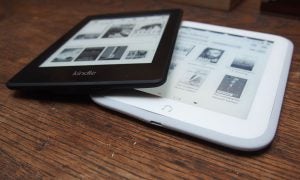Kindle Paperwhite vs Nook GlowLight
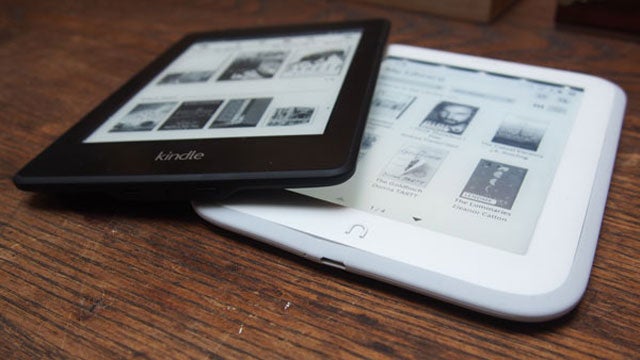
Which is the best backlit eReader?
The Nook GlowLight and the Kindle Paperwhite are the budget backlit ebook readers to beat. With a £20 difference between the two, do you get more for your money with the Paperwhite or is the GlowLight the sub-£100 ebook reader to take on holiday?
We compare the two to find out which one is best.
Related: Kindle Oasis review
Kindle Paperwhite vs Nook GlowLight – Design
Kindle Paperwhite: 206g, Plastic with soft-touch back
Nook GlowLight: 175g, Plastic with soft-touch back and silicone trim
Dimensions-wise, there’s very little to choose between the two. Both are roughly the same size as a small paperback book – though much thinner, of course – and are extremely light to hold in the hand. The Glowlight does opt for a more curvaceous look compared to the Paperwhite’s rectangular design, but both have a soft-touch back.
There’s no physical page turning or expandable memory on either reader, so you’re relying on the touchscreen to get around and internal storage to store all of your ebooks, magazines and newspapers.
The Kindlewhite with its all black tablet-inspired design is the better-looking of the two ebook readers. The GlowLight’s all-white design with silicone trim is a little bit tacky and, as we mentioned in our GlowLight review, the rubber trim can come away from the body. It’s an ebook reader that doesn’t take long to get grubby when it’s been in a bag for a couple of days as well.
Winner: Kindle Paperwhite
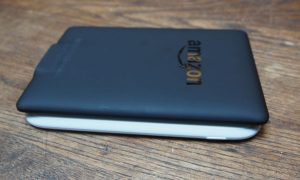
Kindle Paperwhite vs Nook GlowLight – Screen
Kindle Paperwhite: 6-inch 758 x 1024 Paperwhite Carta e-paper display, 212 PPI
Nook GlowLight: 6-inch 758 x 1024 E-Ink Pearl display, 212 PPI
The two displays are identical in the specs department, but there are some subtle differences that are more noticeable when you line up the two e-readers next to each other.
For the GlowLight, the move to a Paperwhite-equalling display is a big improvement on its predecessor, and the ‘Ghosting’ that the previously model suffered from has been eliminated. The new Carta E-ink screen on the Paperwhite, though, aims to improve contrast and to make text appear blacker than on the last-gen Paperwhite. When you compare it to the GlowLight, those blacks do look more impressive on the Amazon e-reader, as do the more accurate white backgrounds to create a better-balanced display.
It doesn’t take long to notice the difference in touchscreen performance either. While the Paperwhite uses a more common capacitive display, the GlowLight uses infrared technology. The responsiveness and reaction to screen interactions is a little slower on the Nook GlowLight. It won’t ruin the e-reading experience altogether, but it could definitely be better.
Winner: Kindle Paperwhite
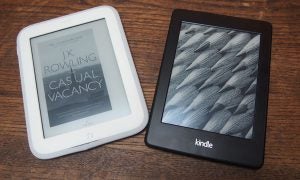
Kindle Paperwhite vs Nook GlowLight: Storage and Connectivity
Kindle Paperwhite: Free cloud storage, 1GB for 1,000 books, 3G and Wi-Fi options
NOOK GlowLight: Free cloud storage, 2GB for 2,000 books, Wi-Fi option
Both the GlowLight and Paperwhite are not short of on-board storage. If you can get through 1,000-2,000 books before finding an opportunity to swap a few around, that’s some impressive reading. There’s cloud storage to back up the internal space, so you can sync and back up books, magazines and newspaper. This also means you can resume reading via compatible Android, iOS and Windows apps.
The GlowLight is only available in a Wi-Fi model, although that might not be a problem for readers who prefer to stock up on books when they’re at home or work. The 3G Kindle Paperwhite model does cost £60 more than the Wi-Fi-only Paperwhite, though the mobile data connectivity is free and works for downloading and using the experimental web browser.
Winner: Tie
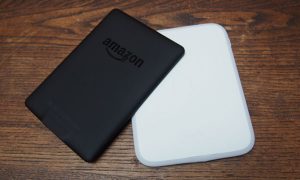
Kindle Paperwhite vs Nook GlowLight – Content, Stores and Pricing
Nook GlowLight: 2.5 million ebooks including newspapers and magazines
Kindle Paperwhite: 3 million ebooks including newspapers and magazines
For many, this is going to be the most important part of picking between the two. Which ebooks can you buy and which is cheaper? Both have extensive libraries of content for starters. You can purchase ebooks and get free samples, all of which can be downloaded directly from the store onto the ebook reader. Amazon has the larger of the two libraries, but both have the newest titles and classics well covered in their respective store fronts.
While newspapers and magazines don’t seem as well suited to e-readers as they do on tablets, you can get a range of formatted versions as one-off purchases or on a monthly subscription. Newspapers are well represented on both, although the Barnes & Noble store appears to feature a more comprehensive range of magazines.
When you venture into the stores, Barnes & Noble creates a more enticing place to explore. The new Popular List and Sales sections make it easier to discover new content, and sections for books, newspapers and magazines are clearly highlighted. It’s just a more straightforward place to purchase books than the Kindle Store.
If pricing is where it will really matters most, the Kindle Store in general is cheaper. Books in the Barnes & Noble store can be as much as £2 to £3 more. It’s roughly the same for magazines and newspapers for monthly and daily purchases, but if you’re looking for more affordable books, then the Paperwhite is the one.
Winner: Kindle Paperwhite
Kindle Paperwhite vs Nook GlowLight – Other Features to Consider
Kindle Paperwhite: Kindle Freetime, X-Ray, Experimental web browser, Kindle loan library, 8-week battery life
Nook GlowLight: ePub file format support, LendMe service, 8-week battery life
For the extra software frills the Paperwhite is well ahead of the GlowLight, but that’s not to say the latter doesn’t have the odd feature some might find more desirable. Such as the fact that it supports the popular ePub format, making it easier to transfer books from other readers and borrow books from libraries. There’s a workaround for Kindles to work with the file format, but it’s going to be more fiddly.
Something that you can do on both is have the option to loan and borrow books to other Nook and Kindle users. There are restrictions in place for how frequently you can do this, and not all books are available through the service. In the case of the Kindle, users that loan books can read them via the free Kindle smartphone and tablet apps, which is not the case on the Nook platform.
In addition to this, Amazon also offers its new Kindle Unlimited steaming-style service where you can pay a monthly fee to access around 600,000 books. It’s currently only available in the US, and there’s no news of when we can expect it in the UK. If you’re an Amazon Prime subscriber as well, you also have access to the Kindle lending library, where you can borrow a book a month for free with no due date.
When you consider other extras such as web browsing, the family-friendly Kindle Freetime and X-ray features, the Kindle Paperwhite is the more feature-packed ebook reader.
Related: Kindle Voyage review
Kindle Paperwhite vs Nook GlowLight – Verdict
This is a comprehensive victory for the Kindle Paperwhite. In some respects, there’s very little between the two ebook readers. However, all those little things add up. Based on the more attractive design, the better screen, cheaper books and extra features, the Kindle is still way out on top and is worth spending that extra money for.


